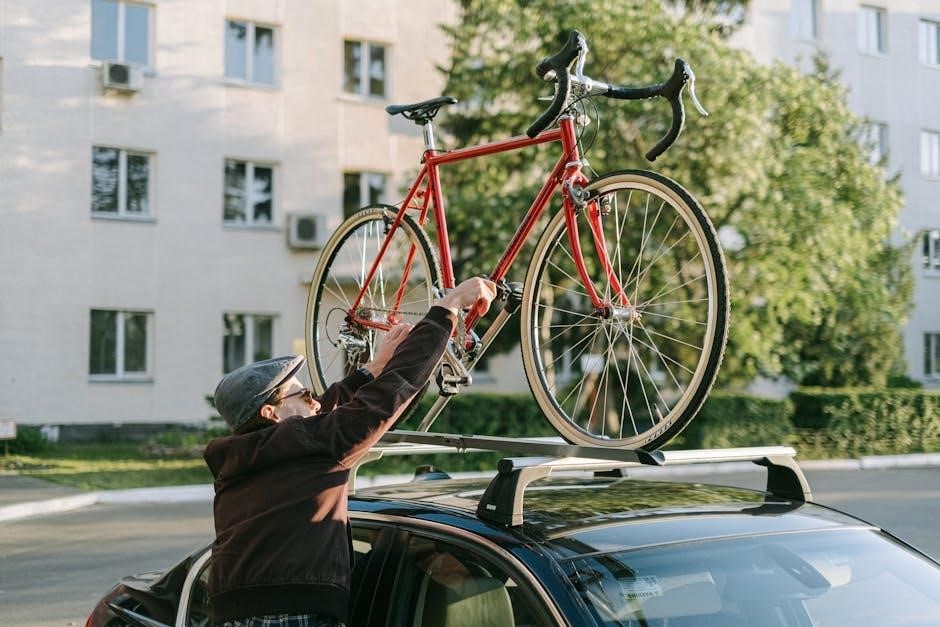rhode gear bike rack instructions
Discover how to efficiently install and use your Rhode Gear bike rack with these detailed instructions‚ ensuring safe and secure bike transportation every time you travel.
Overview of Rhode Gear Bike Racks
Rhode Gear bike racks are known for their durability‚ ease of use‚ and compatibility with various vehicles. Designed to securely transport bikes‚ these racks offer a reliable solution for cyclists. Many models are hitch-mounted‚ providing stability and easy access. They are often pre-assembled‚ making installation straightforward. With options for different vehicle types‚ Rhode Gear racks are versatile and suitable for both casual and avid cyclists. Their sturdy construction ensures bikes remain secure during transit‚ while innovative features like tilt-away designs enhance functionality. These racks are a trusted choice for safe and efficient bike transportation.
Importance of Proper Installation and Use
Proper installation and use of Rhode Gear bike racks are crucial for safety‚ preventing damage‚ and ensuring legal compliance. A poorly installed rack can lead to accidents‚ especially at high speeds‚ and may result in legal penalties. Securely attaching the rack and bikes minimizes the risk of wobbling or detachment‚ protecting both the vehicle and cyclists. Proper use also prevents damage to the bikes and rack‚ ensuring longevity. Following instructions carefully enhances driving confidence and avoids potential hazards‚ making every trip safer and more enjoyable for everyone on the road.

Components of the Rhode Gear Bike Rack
The Rhode Gear bike rack includes a durable frame‚ secure straps‚ hitch mounting hardware‚ and bike attachment points‚ designed for stability and easy bike loading.
Understanding the Rack Frame and Its Parts
The Rhode Gear bike rack features a sturdy‚ pre-assembled frame designed for durability and ease of use. The main beam provides structural support‚ while the attachment arms securely hold bikes in place. Anti-sway cradles prevent bike movement during transit‚ ensuring stability. The frame is compatible with various hitch sizes and includes a locking mechanism for added security. Constructed from rust-resistant materials‚ the rack is built to withstand outdoor conditions. Its lightweight yet robust design makes it easy to handle while maintaining strength for carrying up to two bikes safely and efficiently.
Straps and Securement Systems
Rhode Gear bike racks feature durable‚ adjustable straps designed to securely hold bikes in place. These straps are made from weather-resistant materials‚ ensuring long-lasting performance. The securement system includes padded hooks that gently grip bike frames without causing damage. Easy-to-use buckles allow for quick adjustments‚ ensuring a snug fit. The straps are designed to minimize bike movement during transit‚ providing stability and peace of mind. Regularly inspecting and tightening the straps ensures optimal performance and safety while transporting your bikes.
Hitch and Mounting Hardware
The Rhode Gear bike rack features a sturdy hitch system designed for compatibility with most vehicle hitch receivers. The mounting hardware includes bolts‚ brackets‚ and clips to ensure a secure attachment to your car. Durable materials withstand harsh weather and heavy use‚ providing stability during transit. Easy-to-follow instructions guide you through the hitch installation process‚ ensuring a snug fit. Properly tightened hardware prevents wobbling and ensures bikes remain secure. Always verify hitch compatibility with your vehicle to maximize safety and performance while transporting your bikes.

Preparation for Installation
Begin by cleaning the hitch area and reviewing the manual. Organize tools and hardware‚ ensuring all components are included. Double-check vehicle compatibility before starting.
Tools and Materials Needed
To install the Rhode Gear bike rack‚ gather essential tools and materials. These include an Allen wrench‚ screwdriver‚ torque wrench‚ and lubricant for assembly. Ensure you have a measuring tape for accurate fitting and a pair of gloves for better grip. Additionally‚ keep the instruction manual handy for reference. Verify that all hardware components‚ such as bolts and straps‚ are included in the package. Having these items ready will streamline the installation process and ensure a secure setup for your bike rack.
Choosing the Right Rack for Your Vehicle
Selecting the correct Rhode Gear bike rack for your vehicle is crucial for compatibility and safety. Ensure the rack matches your car’s make‚ model‚ and year‚ as well as its hitch type. Rhode Gear racks are designed for various vehicles‚ including sedans‚ SUVs‚ and trucks. Check the weight capacity and bike loading limits to suit your needs. Some racks are tailored for specific vehicle models‚ so verify compatibility before purchasing. Always consult your vehicle’s manual or manufacturer guidelines for hitch requirements. This ensures a proper fit and safe transportation of your bikes.
Checking Vehicle Compatibility
Before installing a Rhode Gear bike rack‚ ensure it is compatible with your vehicle. Check your car’s hitch type‚ size‚ and weight capacity. Rhode Gear racks are designed for vehicles with standard hitches‚ but compatibility varies by model. Refer to your vehicle’s manual for hitch specifications. Use Rhode Gear’s fit guide or consult a dealer to confirm compatibility. Measure your vehicle’s rear clearance and ensure the rack fits securely without obstructing lights or sensors. Proper compatibility ensures safe and stable bike transportation‚ preventing damage to both your vehicle and bikes.

Installation Steps
Attach the rack to your vehicle’s hitch‚ secure it tightly‚ and ensure proper alignment. Follow the steps to mount the rack‚ then load and secure your bikes. Use the provided hardware and straps to tighten everything firmly for safe transport.
Attaching the Rack to the Vehicle
Start by ensuring your vehicle’s hitch system is compatible with the Rhode Gear rack. Mount the rack onto the hitch‚ aligning the bolts securely. Tighten the bolts firmly to prevent any movement; Double-check the rack’s stability by gently rocking it. Ensure the rack is level and properly seated to avoid wobbling during transit. If your rack comes with additional stabilizers‚ attach them according to the instructions. Finally‚ test the rack’s stability before loading bikes to ensure a safe and secure fit for your vehicle. Always follow the manufacturer’s guidelines for proper attachment.
Securing Bikes to the Rack
Place each bike onto the rack‚ ensuring the tires align with the wheel trays. Use the provided straps to secure the bike frame and wheels firmly to the rack. Tighten the straps evenly to avoid uneven pressure. For added stability‚ attach the secondary straps around the bike’s frame and crossbars. Double-check that all straps are snug and bikes are balanced. Ensure bikes do not touch each other or the vehicle to prevent damage. Finally‚ test the bikes’ stability by gently rocking them to confirm they are securely fastened to the rack.
Tightening and Adjusting
After securing the rack to your vehicle and loading your bikes‚ tighten all straps and bolts firmly. Ensure the rack is stable by checking for any wobbling or movement. Tighten the hitch pin and anti-sway bolts to prevent shifting during transit. Adjust the bike frames and wheels to maintain proper alignment and balance. Double-check all securement points‚ such as straps and hooks‚ to ensure they are snug and holding the bikes in place. Make sure there is no slack in the system‚ as this could lead to instability while driving. Regularly inspect and tighten all connections before and during your trip to ensure safety and prevent damage.

Safety Checks and Precautions
Always inspect the rack and bikes before use‚ ensuring secure attachment to prevent damage or accidents. Follow weight limits and drive cautiously to maintain stability.
Testing the Rack Before Use
Before each use‚ conduct a thorough inspection of the rack and its components. Check for any signs of wear‚ damage‚ or loose hardware. Perform a wobble test by gently rocking the rack to ensure stability. Test the hitch connection and straps for tightness. Load bikes onto the rack and simulate driving conditions to verify securement. Drive a short distance slowly to check for any movement or instability. Address any issues immediately to ensure safe and reliable performance during your trip.
Ensuring Proper Strap and Hitch Security
Tighten all straps firmly to hold bikes in place‚ ensuring no movement during transit. Double-check the hitch pin and anti-rattle device for a snug fit. Verify that all straps are threaded correctly and buckles are securely closed. Test the setup by gently tugging on bikes and straps to confirm stability. Drive cautiously to ensure everything remains secure. Regularly inspect straps and hitch components for wear or damage‚ replacing them as needed to maintain reliability and safety while transporting your bikes.
Driving Safely with the Rack Installed
Always check mirrors and blind spots‚ as the rack and bikes may extend beyond your vehicle. Ensure all straps are tightly secured and the rack is stable. Maintain a safe distance from other vehicles and avoid sudden braking or sharp turns. Reduce speed on rough roads to prevent bike movement. Signal clearly before changing lanes or turning. Stop periodically to inspect the rack and bikes for any signs of loosening. Be aware of parking restrictions and avoid driving in extreme weather conditions. Stay alert to ensure safe transportation of your bikes.
Maintenance and Storage
Regularly clean the rack‚ lubricate moving parts‚ and store it in a dry place when not in use. Inspect for wear and tear to ensure durability.
Cleaning and Lubricating the Rack
To maintain your Rhode Gear bike rack‚ start by removing dirt and grime using a mild soap and water solution. Avoid harsh chemicals or abrasive materials that could damage the finish. Use a soft cloth to wipe down all surfaces‚ paying attention to hinges and moving parts. Dry thoroughly to prevent rust. Apply silicone-based lubricant to any moving components to ensure smooth operation. Regular cleaning and lubrication will extend the rack’s lifespan and keep it functioning properly for years. Always inspect for wear before use.
Storing the Rack When Not in Use
When storing your Rhode Gear bike rack‚ clean it thoroughly to remove dirt and grime. Dry it completely to prevent rust. Store in a cool‚ dry place away from direct sunlight. Use a storage bag or cover to protect it from dust and moisture. If possible‚ hang the rack to save space. Ensure all hardware and straps are securely attached or stored separately to avoid loss. Proper storage maintains the rack’s condition and ensures it remains ready for future use. Regular inspections before storage can also help identify potential issues early.
Regular Inspections
Regular inspections of your Rhode Gear bike rack are crucial for maintaining its performance and safety. Check for signs of wear and tear‚ such as frayed straps‚ rust‚ or loose bolts. Inspect the hitch and mounting hardware for proper alignment and security. Ensure all moving parts are lubricated to prevent corrosion. Examine the frame for any dents or damage that could compromise its stability. Address any issues promptly to avoid larger problems during use. Annual professional inspections can also provide peace of mind and ensure your rack remains reliable for years to come.

Troubleshooting Common Issues
Address common problems like wobbling racks‚ loose straps‚ or hitch misalignment. This section provides practical solutions to ensure your Rhode Gear bike rack functions smoothly and securely.
Addressing Wobbling or Instability
If your Rhode Gear bike rack wobbles‚ check the hitch connection. Ensure it’s tightly secured and properly aligned. Tightening the bolts and verifying the rack’s level can stabilize it. If instability persists‚ inspect the straps and hardware for wear or damage. Replace any worn parts and double-check all connections. A stable rack ensures safe transport‚ preventing bike movement during transit. Regular maintenance and inspections can help avoid such issues altogether‚ ensuring a secure and reliable setup for your biking adventures.
Fixing Loose Straps or Hardware
Loose straps or hardware on your Rhode Gear bike rack can compromise safety. Start by tightening all bolts and nuts using the appropriate tools. If straps are frayed or damaged‚ replace them immediately. For metal components‚ apply a rust-inhibiting lubricant to maintain functionality. Regularly inspect and tighten all connections before and after use. Ensuring everything is secure prevents accidents and extends the rack’s lifespan. Always refer to the manufacturer’s guidelines for specific tightening torque values and replacement recommendations to keep your setup reliable and safe for every journey.
Resolving Hitch Compatibility Problems
If your Rhode Gear bike rack doesn’t fit your vehicle’s hitch‚ check compatibility specs. Ensure the rack matches your hitch size (1.25” or 2”). Use adapters if needed. Consult your vehicle’s manual or contact Rhode Gear support for guidance. Visit a local bike shop for professional assistance if issues persist. Always test the rack’s stability before driving to ensure a secure fit. Proper alignment and snug installation are key to avoiding compatibility issues and ensuring safe transportation of your bikes.
By following these instructions‚ ensure safe and effective use of your Rhode Gear bike rack. Proper installation and regular maintenance will guarantee secure bike transportation every time.
Final Tips for Safe and Effective Use
To ensure safe and effective use of your Rhode Gear bike rack‚ always double-check the installation and securement of bikes before driving. Regularly inspect the rack for wear and tear‚ and lubricate moving parts to maintain functionality. Avoid overloading the rack beyond its capacity‚ and drive carefully to prevent any instability. By adhering to these guidelines‚ you can enjoy hassle-free bike transportation and protect both your vehicle and bicycles from potential damage. Proper maintenance and cautious driving will enhance your overall experience with the Rhode Gear bike rack.